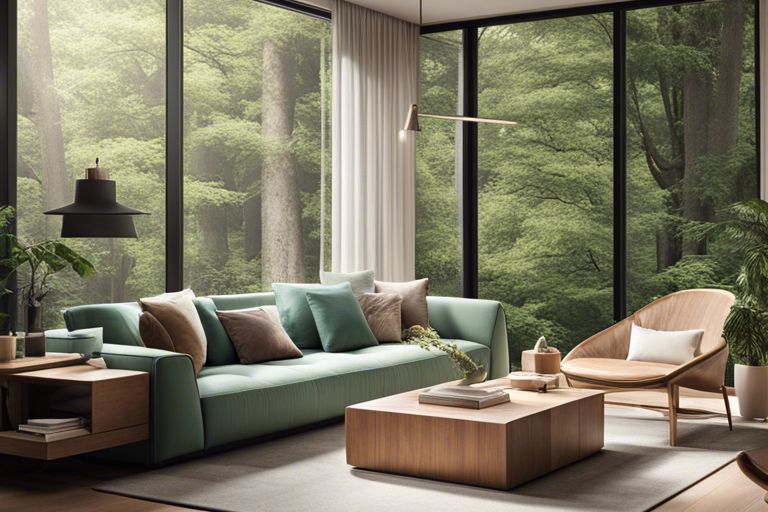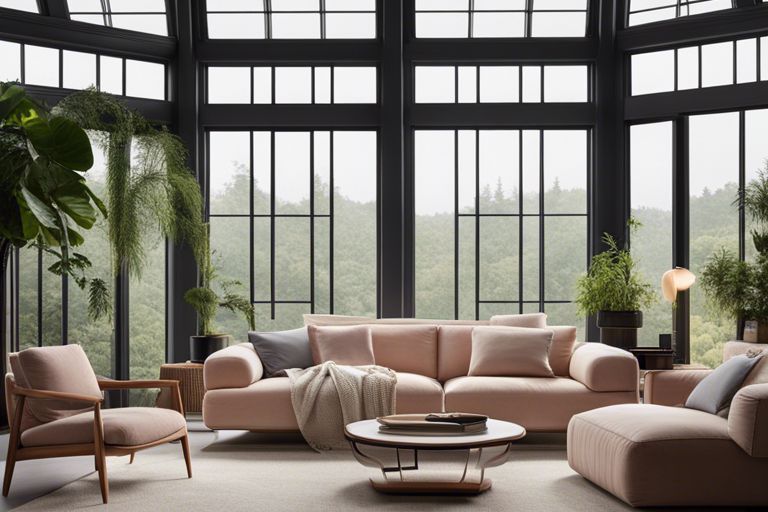You understand the importance of fresh air and natural light in creating harmonious living spaces. In architecture and design, these elements serve as the foundation of biophilic design, a concept that seeks to connect humans with nature through the built environment. Embracing biophilic design principles not only enhances the aesthetic appeal of a space but also contributes to your overall well-being and productivity. Let’s explore how integrating fresh air and natural light can transform your living or working environment into a healthy, vibrant sanctuary.

Key Takeaways:
- Fresh air and natural light are necessary elements in biophilic design: Incorporating these elements into indoor spaces can positively impact human health and well-being.
- Connection to nature: By bringing in fresh air and natural light, spaces become more inviting, calming, and reminiscent of the outdoors.
- Enhancing productivity and mood: Biophilic design, with its focus on natural elements, has been shown to increase productivity, creativity, and overall mood in indoor environments.
The Importance of Fresh Air
While you may not always think about it, the air you breathe has a significant impact on your overall well-being. Fresh air is crucial for maintaining good health and cognitive function. Poor indoor air quality can lead to a variety of health problems, including allergies, asthma, headaches, fatigue, and even more severe respiratory conditions.
The Impact of Indoor Air Quality on Human Health
Fresh air is vital for reducing the concentration of indoor air pollutants like volatile organic compounds (VOCs) and mold spores. These pollutants can accumulate in enclosed spaces and have a detrimental effect on your health. Improving ventilation and introducing more fresh air into your living or working environment can help combat these indoor air pollutants and create a healthier indoor atmosphere for you to thrive in.
How Biophilic Design Can Improve Ventilation
An effective way to enhance ventilation in indoor spaces is through incorporating biophilic design principles. Biophilic design focuses on connecting indoor environments with nature, and one of the key elements is maximizing natural ventilation. By incorporating features like operable windows, atriums, and green walls, you can increase the flow of fresh air into your space, reducing the concentration of indoor air pollutants and improving overall air quality.
Plus, enhanced ventilation not only improves the quality of the air you breathe but also enhances your sense of well-being and productivity. Studies have shown that proper ventilation and access to fresh air can lead to better cognitive function, increased focus, and overall satisfaction in indoor environments. So, by embracing biophilic design principles and prioritizing ventilation, you can create a healthier and more revitalizing space for yourself.
Harnessing Natural Light
Clearly, natural light plays a vital role in biophilic design, as it not only enhances the aesthetic appeal of a space but also has numerous benefits for your well-being. By harnessing natural light, you can create a harmonious environment that promotes a sense of connection to the outdoors.
The Psychological Benefits of Daylight Exposure
Natural light exposure has been linked to various psychological benefits, including improved mood, increased productivity, and better overall health. Daylight can help regulate your circadian rhythm, leading to better sleep patterns and a more balanced emotional state. Additionally, exposure to natural light has been shown to reduce stress and anxiety levels, promoting a sense of calm and well-being.
Design Strategies for Maximizing Natural Light
For biophilic design to be effective, it is imperative to incorporate strategies that maximize natural light within a space. This can be achieved through the use of large windows, skylights, and light-colored reflective surfaces that help distribute sunlight throughout the room. Strategically placing furniture and incorporating light-reflecting materials can also help optimize natural light penetration and create a bright and inviting atmosphere.
A well-lit space not only enhances the visual appeal of your environment but also has a significant impact on your overall well-being. By implementing design strategies that maximize natural light, you can create a space that promotes positivity, productivity, and a sense of connection to nature.
The Interplay Between Fresh Air and Natural Light
Not only do fresh air and natural light contribute to a healthier living environment individually, but they also work together to create a truly invigorating and harmonious space for you. Fresh air helps to regulate temperature, reduce indoor pollutants, and promote better respiratory health. Natural light, on the other hand, not only illuminates the space but also plays a role in regulating your circadian rhythms and boosting your mood.
How Air and Light Work Together to Create a Healthy Environment
Work in tandem, fresh air and natural light create a synergy that enhances your overall well-being. Fresh air helps to circulate natural light throughout the space, ensuring that every corner is bathed in the sunlight’s warmth and brightness. This interplay not only improves the aesthetics of the space but also contributes to a healthier and more inviting environment for you to enjoy.
The Role of Building Orientation and Layout
An optimal building orientation and layout can maximize the benefits of natural light and fresh air in your living or working space. By strategically placing windows and openings, you can harness the sunlight and breezes to create a naturally illuminated and well-ventilated environment. Additionally, thoughtful design considerations such as atriums, courtyards, and green spaces can further enhance the connection between indoor and outdoor elements, promoting a sense of harmony and tranquility in your surroundings.
Biophilic Design Principles
All Biophilic Design as a Holistic Approach to Healthier Buildings, focus on incorporating elements of nature into the built environment to improve well-being and overall satisfaction. There are several key principles that guide the implementation of biophilic design, creating spaces that foster a deep connection with nature.
Connecting Occupants with Nature
With biophilic design, the goal is to connect you with nature on a visceral level, whether it’s through access to natural views, sounds of a running stream, or feeling the warm sunlight on your skin. By incorporating elements like green walls, indoor plants, or water features, you can experience the benefits of nature even while indoors, promoting a sense of calm and well-being.
Using Natural Materials and Textures
Principles of biophilic design emphasize the use of natural materials and textures to create a harmonious environment that mimics the outdoors. From wooden furniture to stone accents, incorporating these elements in your space can evoke a sense of tranquility and connection to nature. Design choices that reflect the natural world not only enhance the aesthetic appeal of a space but also contribute to a healthier and more sustainable living environment.
Overcoming Challenges in Urban Environments
Despite the hustle and bustle of urban living, incorporating biophilic design elements in your space can help you reconnect with nature and improve your overall well-being.
Addressing Limited Natural Light in Cities
The lack of natural light in urban environments can be a common challenge, but there are ways to overcome this obstacle. Maximizing the use of reflective surfaces such as mirrors or light-colored walls can help bounce natural light deeper into your space, creating a brighter and more inviting atmosphere. Additionally, strategic placement of windows and skylights can increase the penetration of sunlight, making your environment feel more connected to the outdoors.
Innovative Solutions for Improving Air Quality
Addressing air quality issues in urban settings is crucial for creating a healthy living environment. This is where innovative solutions like green walls and living facades come into play. These features not only add a touch of nature to your space but also help purify the air by absorbing pollutants and releasing oxygen. Incorporating air-purifying plants throughout your space is another effective way to enhance indoor air quality and promote a sense of well-being.
The Future of Biophilic Design
After exploring the principles and benefits of biophilic design, it’s vital to look towards the future of this innovative approach to creating spaces that connect us with nature. As technology advances and awareness of the importance of incorporating nature into our built environments grows, the possibilities for biophilic design are expanding.
Emerging Trends and Technologies
Emerging trends and technologies are shaping the future of biophilic design, offering new ways to integrate natural elements into our surroundings. From green walls that purify the air to smart systems that mimic natural light patterns, designers are constantly exploring innovative ways to bring the outdoors inside. With the rise of sustainable materials and building practices, the potential for creating biophilic spaces that benefit both people and the planet is greater than ever before.
The Potential for Positive Environmental Impact
Design that embraces biophilic principles has the potential to not only enhance the well-being of individuals but also contribute to a more sustainable future. By incorporating elements such as indoor plants, natural light, and views of nature, buildings can reduce energy consumption, improve air quality, and promote a sense of connection to the natural world. This holistic approach to design has the power to transform our built environments into healthier, more environmentally friendly spaces that prioritize the well-being of both people and the planet.
To wrap up
With this in mind, it is crucial to prioritize fresh air and natural light when designing your spaces to create a biophilic environment. By incorporating these elements, you not only enhance the aesthetic appeal of your space but also promote a healthier and more productive lifestyle. Embracing biophilic principles can have a positive impact on your well-being and connection to the natural world around you.
Do not forget, when designing your space, think about how you can bring the outdoors in and create a harmonious balance between nature and man-made structures. By focusing on incorporating fresh air and natural light, you can lay the foundation for a biophilic design that is not only visually stunning but also beneficial for your overall health and happiness.
FAQ
Q: What is biophilic design?
A: Biophilic design is an innovative approach to architecture and interior design that incorporates elements of nature to create a more harmonious and human-centered built environment.
Q: How does fresh air contribute to biophilic design?
A: Fresh air is imperative in biophilic design as it not only improves indoor air quality but also promotes a sense of wellbeing and connection to the natural world, creating a healthier and more productive space for occupants.
Q: Why is natural light important in biophilic design?
A: Natural light is a key element in biophilic design as it has the ability to enhance mood, reduce stress, and improve overall health. It also helps to bring the outdoors inside, creating a seamless connection to nature within the built environment.

